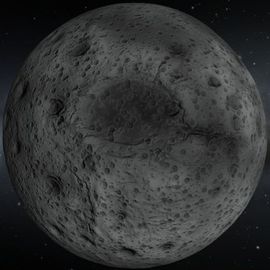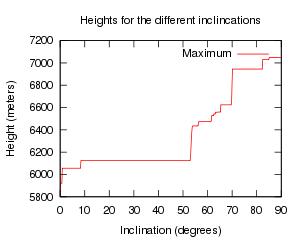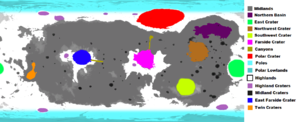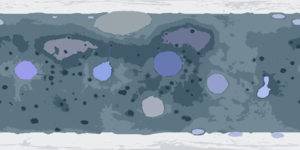Difference between revisions of "Mun"
GregroxMun (talk | contribs) (→Trivia) |
(Too many flags.) |
||
| Line 88: | Line 88: | ||
File:Isa_mapsat_mun_map800.gif|A topographic height map of the mun made with the ISA MapSat plugin | File:Isa_mapsat_mun_map800.gif|A topographic height map of the mun made with the ISA MapSat plugin | ||
File:Large lander on Mun.png | A successful landing on the Mun with a two-kerbal capsule. This is often a milestone for new players. | File:Large lander on Mun.png | A successful landing on the Mun with a two-kerbal capsule. This is often a milestone for new players. | ||
| − | File:0.21 Kerbal Staring Sun From Moon --Copyright by Squad--.jpg| A kerbal watching the sunrise on the moon | + | File:0.21 Kerbal Staring Sun From Moon --Copyright by Squad--.jpg| A kerbal watching the sunrise on the moon. |
| − | |||
| − | |||
File:MoonRoverNight.png | A rover driving across a Mun crater in the night. | File:MoonRoverNight.png | A rover driving across a Mun crater in the night. | ||
File:Solar Eclipse.jpg | A solar eclipse caused by the Mun. The vehicle has run out of electric charge because the sun is blocked. | File:Solar Eclipse.jpg | A solar eclipse caused by the Mun. The vehicle has run out of electric charge because the sun is blocked. | ||
Revision as of 06:53, 15 August 2016
| Mun | ||
| Mun as seen from orbit. | ||
| Moon of Kerbin | ||
| Orbital Characteristics | ||
| Semi-major axis | 12 000 000 m [Note 1] | |
| Apoapsis | 12 000 000 m [Note 1] | |
| Periapsis | 12 000 000 m [Note 1] | |
| Orbital eccentricity | 0 | |
| Orbital inclination | 0 ° | |
| Argument of periapsis | 0 ° | |
| Longitude of the ascending node | 0 ° | |
| Mean anomaly | 1.7 rad (at 0s UT) | |
| Sidereal orbital period | 138 984 s | |
| 6 d 2 h 36 m 24.4 s | ||
| Synodic orbital period | 141 115.4 s | |
| Orbital velocity | 543 m/s | |
| Longest time eclipsed | 2 213 s | |
| Physical Characteristics | ||
| Equatorial radius | 200 000 m | |
| Equatorial circumference | 1 256 637 m | |
| Surface area | 5.0265482×1011 m2 | |
| Mass | 9.7599066×1020 kg | |
| Standard gravitational parameter | 6.5138398×1010 m3/s2 | |
| Density | 29 125.076 kg/m3 | |
| Surface gravity | 1.63 m/s2 (0.166 g) | |
| Escape velocity | 807.08 m/s | |
| Sidereal rotation period | 138 984.38 s | |
| 6 d 2 h 36 m 24.4 s | ||
| Sidereal rotational velocity | 9.0416 m/s | |
| Synchronous orbit | Outside sphere of influence | |
| Sphere of influence | 2 429 559.1 m [Note 1] | |
| Atmospheric Characteristics | ||
| Atmosphere present | No | |
| Scientific multiplier | ||
| Surface | 4 | |
| Splashed | N/A | |
| Near space | 3 | |
| Outer space | 2 | |
| Recovery | 2 | |
|
| ||
Mun, also known as the Mun and sometimes written as Mün, is a relatively large moon orbiting Kerbin. It can be thought of as an analogue to Earth's own moon, which frequently is simply called “the Moon” (Latin: Luna).
It is gray in appearance with craters of various sizes and mountains exceeding 5029 m in height. The gravitational pull on the surface is 1.63 m/s², approximately 1/6 and 8.18 m/s² lower than that of Kerbin and about the surface gravity of Earth's Moon (1.624 m/s²). It is possible to land on the Mun or use it for gravity assist (gravitational slingshots) to outer bodies such as Minmus or into Kerbol orbit, though such maneuvers do not save very much fuel and are more imprecise. It is, however, useful for plane changes with proper timing.
New players should note that Mun (like the majority of celestial bodies in the game) has no atmosphere. That means parachutes do not work when descending to the surface.
There are anomalous geological formations that can be found on the surface of the Mun.
Synchronous orbit around the Mun is not possible, since it would have to occur at an altitude of 2 970.58 km, beyond the Mun's sphere of influence. However, putting your spacecraft just outside Mun's SOI and having the same semi-major axis would make it appear stationary. A normal 25 km orbit can be achieved using around 800 m/s delta V. A semi-synchronous orbit with half the rotation period of the Mun is possible at approximately 1797.41 kilometers.
There is a tutorial about traveling to the Mun.
Contents
In-game Description
| “ | The Mun, is a large satellite orbiting Kerbin. It is mostly grey in appearance, with craters of various sizes dotting its otherwise smooth surface. The Mun's discovery is widely regarded as one of the more important breakthroughs of Kerbal evolution. Granted it didn’t happen all that long ago, but its still fair to say that Kerbals are wiser and more evolved now than they were back then. |
” |
Terrain
The Mun's terrain is rough, grey, and scarred by craters. Its low-lying areas tend to be darker in colour. The Mun also features canyons which can be hundreds of meters deep and a few kilometers long.
The Mun's highest points reach a maximum altitude of more than 7061 m near the south pole at 152.33° W and 82.52° S. This altitude permits 10× warp, allowing crashes with terrain while being in a seemingly stable orbit. Its lowest point, below -247 m, is on the northern hemisphere south-west of the large northern crater at 76.63° W and 35.32° N.
When terrain scatter is activated in the graphics settings, the Mun has rocks scattered on its surface. Like all terrain scatters, these rocks are strictly cosmetic and do not collide with ships or Kerbals.
As of 0.21 the Mun is peppered with procedural impact craters making Mun landing more difficult. Previously the lowest point with an altitude of 0 m was on the east side of a large crater, at 35.42° E, 8.27° N.
The Hell Kraken has been encountered on the Mun, with objects being thrown out of Kerbin's sphere of influence upon reloading the craft.
The Mun also has several hidden surprises for explorers to find:
- There are three large stone arches. Due to their size they can be spotted easily from a low (<10km) orbit near the equator.
- There is a memorial honouring Neil Armstrong, the first man on the moon. It can be found inside one of the largest craters, near the south wall. It is at nearly the same coordinates where Apollo 11 first landed on the moon. It appears as a tiny white dot from low orbit.
- There are three monoliths ("Munoliths"). These are very hard to find because of their small size. One is partially underground, one is on top of a steep hill and is at the bottom of a deep, steep-sided valley.
Biomes
Before 0.90 the Mun was one of the few bodies with multiple biomes and has, with a total of 15, the most biomes of any celestial body other than Kerbin. Each major crater is a distinct biome, which gives them somewhat official names; however, like all biome names, they are fairly generic. The Midlands and Highlands biomes each have a biome applied to any of the nameless large craters within them. The polar regions also have three different biomes.Biome list
|
Observation from Kerbin
The Mun's orbit keeps it directly above Kerbin's equator. Because the Mun is tidally locked to Kerbin with a perfectly circular, non-inclined orbit, exactly 50% of the Mun's surface (excluding areas on the edge obscured by the Mun's mountains) is ever visible from Kerbin.
Due to the Mun's non-inclined orbit, solar eclipses occur every time the Mun goes between the Sun and Kerbin. Due to graphic engine limitations, these solar eclipses currently do not make the sky black, or darken the land. However, solar panels will become blocked by the Mun in an eclipse and become useless for a short period of time.
Although the game graphics depict Mun as totally covering the solar disk during an eclipse, based on the given diameters of Sun and Mun and their distances from Kerbin, Sun has a larger apparent size. For observers on and near Kerbin, solar eclipses would be annular.
Observation of Kerbin
Because Mun is tidally locked to Kerbin, Kerbin is only visible from 50% of the Mun's surface, and Kerbin never sets or rises as seen from the Mun. The Mun longitude for which Kerbin remains directly above in the sky (at the zenith) is about 47 degrees east. The Mun's equator is coplanar with Kerbin's, so any location on the Mun's equator that faces Kerbin will also face Kerbin's equator. Kerbin is not tidally locked to the Mun, so any point on the Mun where Kerbin is not obscured by the Mun's landscape will be able to observe every point on Kerbin as Kerbin rotates. Kerbin's synodic rotational period with the Mun is 25617.909 seconds, or 1.18323 Kerbin solar days.
Science
Although the science-multipliers of Mun's surface and orbit are quite low compared to that of other planets and moons, Mun is comparably easy to reach and has a very large number of biomes which all yield different science results. This makes it - together with Minmus - the main source of science points during the midgame.
Reference Frames
| Time warp | Minimum Altitude |
|---|---|
| 1× | Any |
| 5× | 5 000 m |
| 10× | 5 000 m |
| 50× | 10 000 m |
| 100× | 25 000 m |
| 1 000× | 50 000 m |
| 10 000× | 100 000 m |
| 100 000× | 200 000 m |
Gallery
- Error creating thumbnail: File missing
Four kerbals manning a Mun base
Trivia
- After its implementation, many fans began calling the body Mün, pronounced the same as "moon", believing the original spelling to be a mistake. However, several of the game's developers have been heard referring to it as Mun, pronounced "muhn". In the "Surface of the Mün" title screen, a crashed lander resembling a Kerbal X has the words "Mün or Bust" scrawled on the side. Both spellings are generally accepted, however the spelling in-game is Mun, despite the fact that planets can have non-english letters in them.
- Mun was Kerbin's, and indeed the game's, very first moon.
- Mun's orbit is perfectly circular and has zero orbital inclination. Such an orbit in reality would be very unlikely since this would require precise positioning of any dust/bodies that created it during the planetary system's formation, as well as the absence of a central star or other planets.
- This was likely done to make it easier to reach for new players.
- Prior to version 0.14.2, the tallest points on the munar surface were no higher than roughly 600m.
- Before introduction of procedural terrain the Mun's highest point was within 45° latitude of the equator, had an altitude of 2967 m and was located at 129.64° W, 0.97° N, on the north side of a canyon which was on the east edge of a large crater.
- Prior to version 0.14.3 a KSC could be found on the Mün.
- The Mun is considerably larger than 1/10 the size of the real world Moon.
- The Mun is one of the few bodies in the solar system that is almost completely manually colored. Most other planets and moons are colored procedurally or with a lot of procedural colors doing the work. The only procedural colors on the Mun are associated with the procedural craters.
Changes
- New Procedurally generated craters.
- Height values reverted
- Terrain overhaul
- Easter Eggs added (one fixed, one added)
- New small art pass.
- Texture Improvements
- Easter Eggs added
- Texture Improvements
- Removed KSC on it.(don't ask)
- Terrain overhaul
- Initial Release
Notes
















